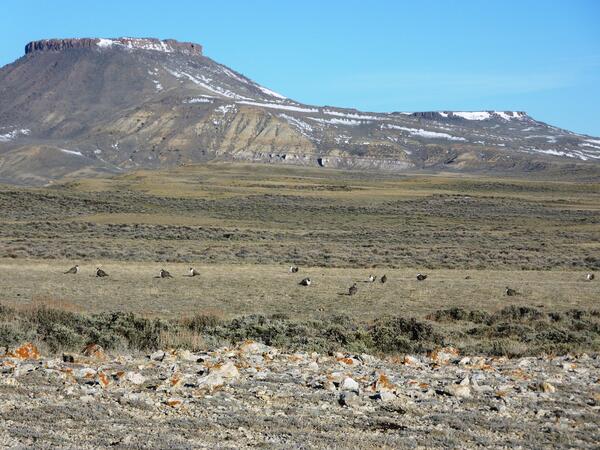Estimating locally relevant scales of effect for population trends of a species of conservation concern
Wildlife movement and distribution can be influenced by local conditions like topography and landscape features, and the distances within which species respond to their landscape – scales of effect – can vary over space and time. We are estimating scales of effect for wildlife population trends to help land managers determine the distance within which wildlife will respond to landscape change.
Understanding how species respond to landscape features requires determining the scales of effect, or distances within which a species’ response extends. An accurate understanding of scales of effect not only helps anticipate population responses to landscape change but can also inform management actions that aim to limit disturbance or direct disturbance away from affected species. Scale can also indicate the size of restoration needed to positively influence populations. As with other ecological relationships, scales of effect likely vary over space and time, particularly for species with broad geographic ranges. Nevertheless, scales of effect are often assumed to be constant over space and time. Failing to accurately determine local scales of effect could indicate spurious relationships with landscape components, leading to incorrect inferences and wasted resources.

Within sagebrush (Artemisia spp.) ecosystems of the western United States, the greater sage-grouse (Centrocercus urophasianus; hereafter, sage-grouse) is a sagebrush-obligate species with a broad range. Long-term and widespread population declines prompted states and federal agencies to seek relevant spatial scales for accommodating multiple land-use types in sage-grouse habitat. Although directly estimating scales of effect relevant to a study system is increasingly common, researchers seldom estimate scales that are site-specific. However, there is reason to suspect scales of effect are not constant across the sage-grouse range, as sage-grouse movement and distribution can be influenced by local conditions such as topography, landscape configuration, and population size.
To test for variation across time and space in spatial scales of effect around sage-grouse breeding display sites (leks), we are using a standardized, range-wide dataset of sage-grouse lek counts. We are estimating the effect of sagebrush cover on sage-grouse population trends across their range while jointly estimating scales of effect. We compare performance between models with and without variation in spatial scales of effect and assess for mechanisms driving variation including topography, landscape configuration, population size, and other site-level variation. Results from this work will offer federal and state partners an empirical basis to inform disturbance buffers throughout the sage-grouse range, thereby expediting decision-making for land managers.
Shrubland, Alpine and Grassland Ecology (SAGE) Wildlife Research Group
Greater Sage-Grouse Population Monitoring Framework
Data Harmonization for Greater Sage-Grouse Populations
Hierarchical Units of Greater Sage-Grouse Populations Informing Wildlife Management
Sagebrush (Artemisia spp.) scale of effect for Greater Sage-grouse (Centrocercus urophasianus) population trends in southwest Wyoming, USA 2003-2019 Sagebrush (Artemisia spp.) scale of effect for Greater Sage-grouse (Centrocercus urophasianus) population trends in southwest Wyoming, USA 2003-2019
Spatial scale selection for informing species conservation in a changing landscape Spatial scale selection for informing species conservation in a changing landscape
Spatial scale selection for greater sage-grouse population trends, Version 1.0.0 Spatial scale selection for greater sage-grouse population trends, Version 1.0.0
Wildlife movement and distribution can be influenced by local conditions like topography and landscape features, and the distances within which species respond to their landscape – scales of effect – can vary over space and time. We are estimating scales of effect for wildlife population trends to help land managers determine the distance within which wildlife will respond to landscape change.
Understanding how species respond to landscape features requires determining the scales of effect, or distances within which a species’ response extends. An accurate understanding of scales of effect not only helps anticipate population responses to landscape change but can also inform management actions that aim to limit disturbance or direct disturbance away from affected species. Scale can also indicate the size of restoration needed to positively influence populations. As with other ecological relationships, scales of effect likely vary over space and time, particularly for species with broad geographic ranges. Nevertheless, scales of effect are often assumed to be constant over space and time. Failing to accurately determine local scales of effect could indicate spurious relationships with landscape components, leading to incorrect inferences and wasted resources.

Within sagebrush (Artemisia spp.) ecosystems of the western United States, the greater sage-grouse (Centrocercus urophasianus; hereafter, sage-grouse) is a sagebrush-obligate species with a broad range. Long-term and widespread population declines prompted states and federal agencies to seek relevant spatial scales for accommodating multiple land-use types in sage-grouse habitat. Although directly estimating scales of effect relevant to a study system is increasingly common, researchers seldom estimate scales that are site-specific. However, there is reason to suspect scales of effect are not constant across the sage-grouse range, as sage-grouse movement and distribution can be influenced by local conditions such as topography, landscape configuration, and population size.
To test for variation across time and space in spatial scales of effect around sage-grouse breeding display sites (leks), we are using a standardized, range-wide dataset of sage-grouse lek counts. We are estimating the effect of sagebrush cover on sage-grouse population trends across their range while jointly estimating scales of effect. We compare performance between models with and without variation in spatial scales of effect and assess for mechanisms driving variation including topography, landscape configuration, population size, and other site-level variation. Results from this work will offer federal and state partners an empirical basis to inform disturbance buffers throughout the sage-grouse range, thereby expediting decision-making for land managers.





